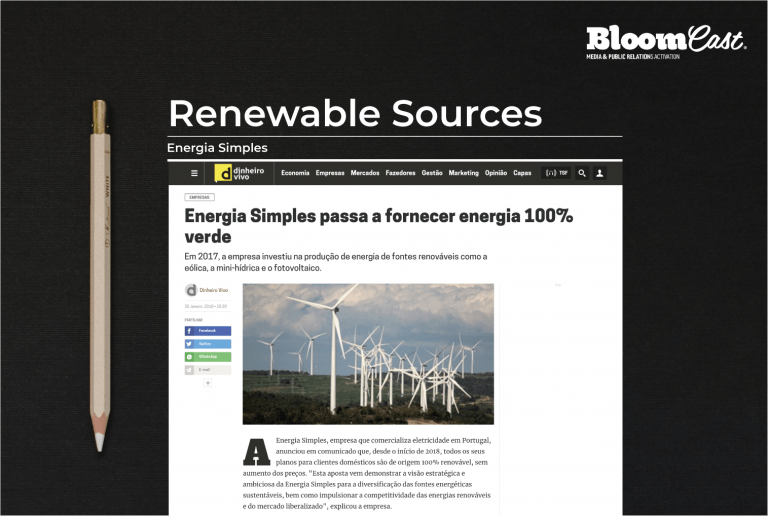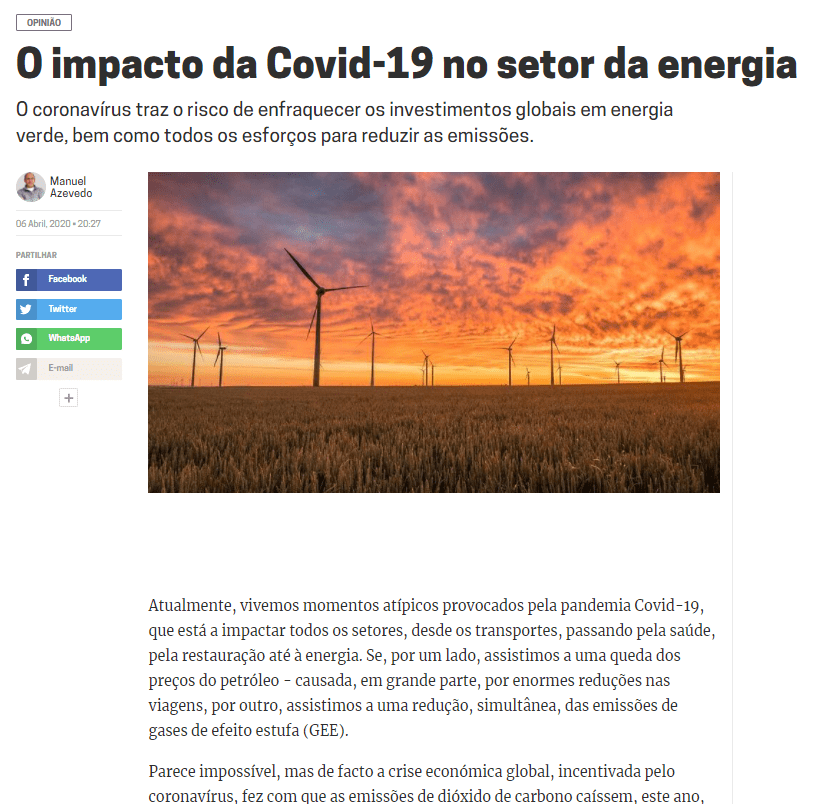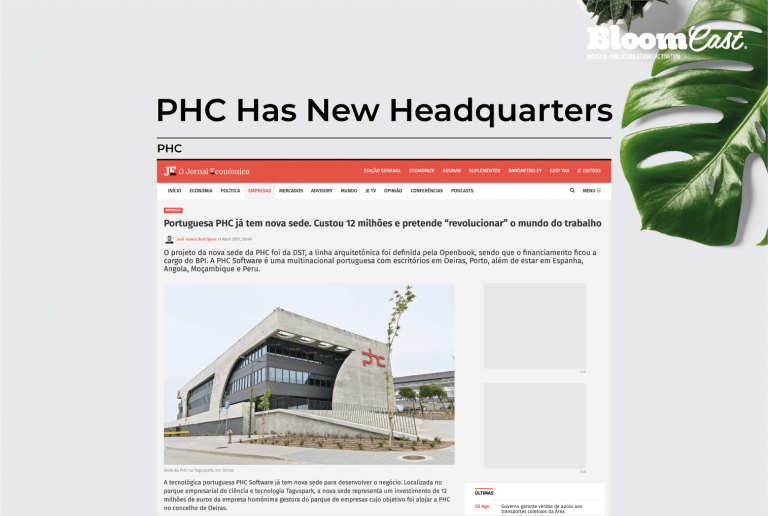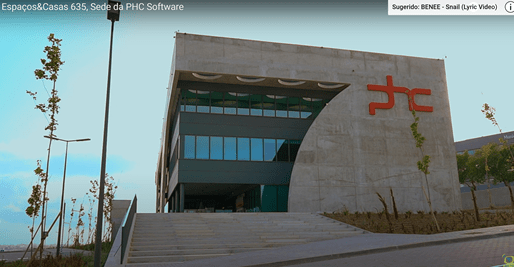OUR PROJECTS
Energia Simples is a brand owned by PH Energia, Lda. to operate on the liberalized electricity market. Based on Oporto, Energia Simples was founded in November 2014 by renowned professionals with know-how in the energy, engineering, and technology fields. They shared common concerns on energy efficiency, environmental sustainability, and business ethics.
The concerns are all mirrored in what they are, internally and externally. The company offers self-consumption solutions that produce 100% renewable energy. To reduce their ecological footprint, environmentally friendly measures are being enforced inside the Energia Simples, and the team has gone fully digital.
The company is strengthening its presence in the Portuguese market, communicating consistently and coherently, through impactful key messages.
Energia Simples is working with BloomCast since October 2016.
THE CHALLENGE:
To strengthen the profile of Energia Simples, as well as place its CEO as an Opinion Leader in the Portuguese market, positioning them as a reference in the energy, innovation, and technology sectors.
To this end, it was and continues to be necessary to work on two fundamental axes: the importance of the liberalized market and sustainability, with the purchase of green energy.
The challenge was the need to create key messages that show the differentiation of Energia Simples in a competitive and little differentiated market. That was the main goal – communicating Energia Simples’ strategic vision in the energy efficiency field and its knowledge of the sector, as well as its challenges, mentioning its unique selling points.
The workflow is based on interconnected and current topics, such as: renewable energies, sustainability, the importance of energy communities, electric vehicles, hydrogen, peer-to-peer. The NZEB buildings are also a huge challenge, as it is essential to be up to date and communicate according to current measures implemented by the government and the European Union.
Over the past few years, Energia Simples has invested heavily in the production of energy from renewable sources, such as wind, mini-hydro and photovoltaic, having therefore installed more than eleven small-scale solar plants distributed all over the country, in a clear commitment to the future of this technology. It also invested in making all its Electricity Plans for private customers 100% renewable, without increasing costs.
This commitment shows the strategic and ambitious vision of Energia Simples for the diversification of sustainable energy sources, as well as boosting renewable energies and the liberalized market.
OUR PROPOSAL/RESPOSTA
Deliverables:
- Strategic consulting
- Media relations strategy
- One-to-one communication with specific media outlets
- Content development
- Social media strategy
- Crisis management
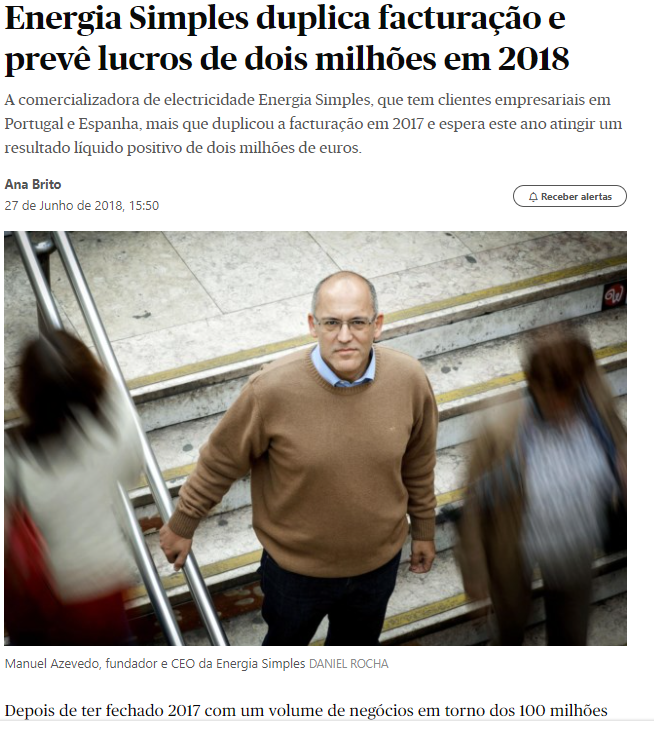
https://www.publico.pt/2018/06/27/economia/noticia/energia-simples-duplica-facturacao-e-espera-lucro-de-dois-milhoes-em-2018-1836077
The approach proposed involves the definition of messages to demonstrate Energia Simples’ differentiation in a sector where services are little differentiated in terms of the common user’s perception and where the idea of benefits is not fully clear.
In the beginning, it was also planned an event to present and make known the unique characteristics that differentiate the company, taking the opportunity to foster a goodwill relationship – the proposal was a breakfast meeting with key media outlets to Energia Simples.
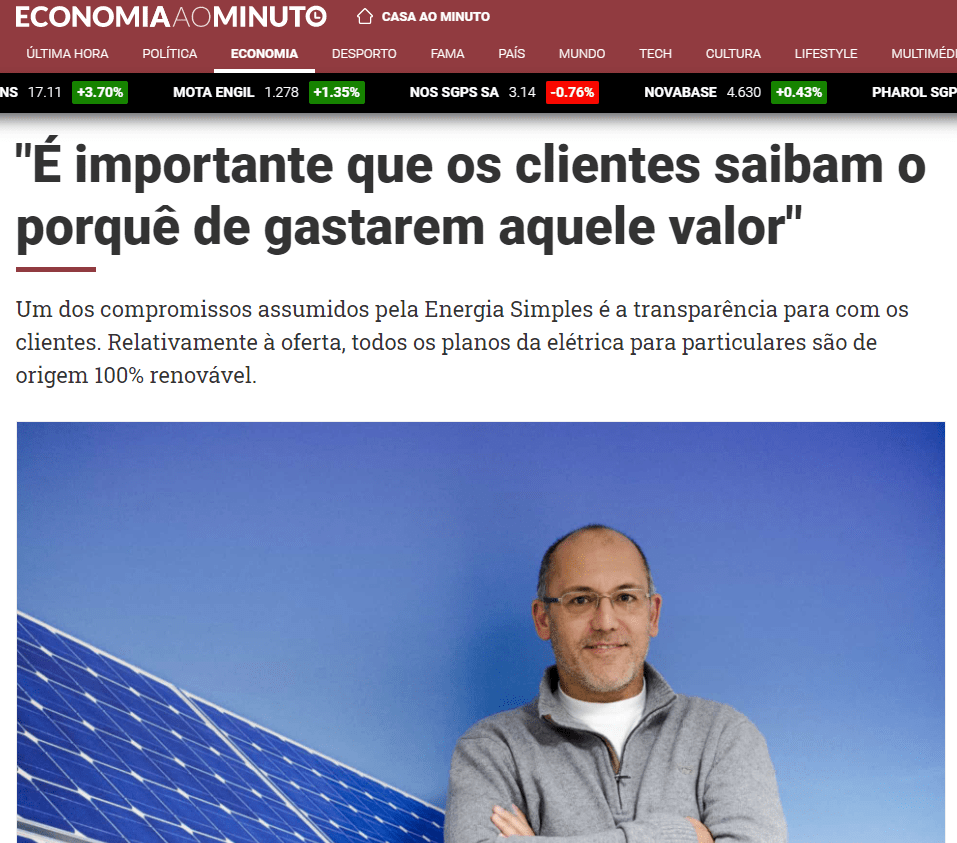
https://www.noticiasaominuto.com/economia/1081126/e-importante-que-os-clientes-saibam-o-porque-de-gastarem-aquele-valor
Over the years, several subjects have been communicated, from new partnerships that were established, one of which with Vitória de Guimarães, to public tenders that were won – such as Bank of Portugal, Douro Intermunicipal Community and for Guarda-, to the creation of the First Parque Solar no Mercado Livre, the pioneer project in Portugal, inteGRIDy, among others.
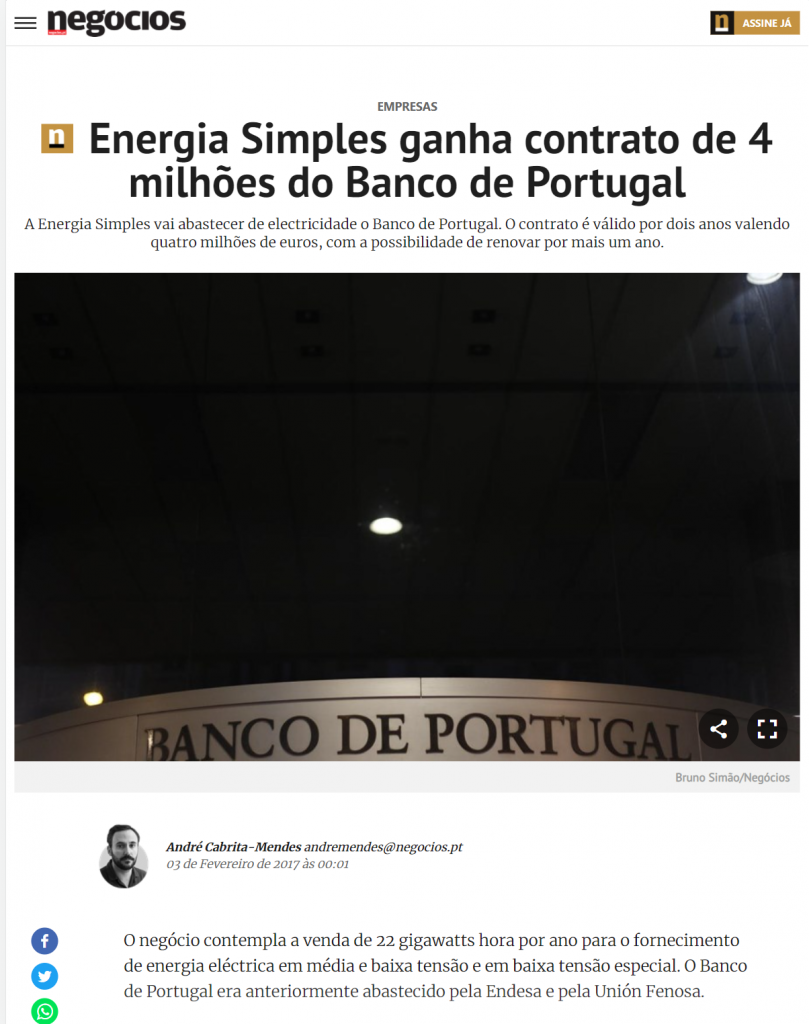
https://www.jornaldenegocios.pt/empresas/detalhe/energia-simples-ganha-contrato-de-4-milhoes-do-banco-de-portugal
The expansion into the Spanish market to supply electricity was also a moment of huge media impact.
Through op-ed articles and interviews, Manuel Azevedo, CEO of Energia Simples, has been regularly voicing the company’s expertise in the energy sector, which allows to reinforce and consolidate the vision of Energia Simples as a leading company that follows the main technological trends.
One of the actions was an editorial partnership with Vida Económica, a news outlet with a strong implementation in the northern region of Portugal, where Energia Simples has its greatest presence. The company’s CEO writes op-ed pieces regularly.
To strengthen the company’s identity, extensive relational work has also been carried out with the specialized news outlets, in order to position Manuel Azevedo as an Opinion Leader in this sector. Articles were published namely at Público, Expresso, Jornal de Negócios, Dinheiro Vivo, and Notícias ao Minuto.
“From an early stage, BloomCast has participated in the definition and implementation of an Energia Simples strategy for the media. Our growth has always been accompanied by the BloomCast team and expectations overcome with excellent results. As a long-term partner, it has a strong strategic sense that has allowed us, at every moment, to reach a wider audience with rigor and professionalism”, says Manuel Azevedo, CEO of Energia Simples.
Find out more about Energia Simples here.
Here, to see other Success Cases.
26OUR PROJECTS
PHC Software is a Portuguese multinational dedicated to the development of innovative management solutions.
The recent opening of the new headquarters, named House of Digital Business, was an opportunity to communicate this project focused on the promotion of employees’ well-being and the innovation of the technological ecosystem in Portugal.
PHC is working with BloomCast since 2017.
THE CHALLENGE:
To increase PHC’s notoriety as one of the best companies to work for in Portugal and communicate a new corporate identity: “Better Management for Happier People”.
The communication of the new facilities began to be designed and carried out in 2019, involving three identities: PHC Software, TagusPark, and Openbook Architecture, the architects responsible for the building’s design.
In 2019, the focus was on the renovation of Taguspark and the investment made with the headquarters of PHC Software. One year later, there was a shift to the concept of “Best Experience at Work”, and how the change would bring the company closer to the best working experiences.

2019: https://www.idealista.pt/news/financas/investimentos/2019/11/06/41417-nova-sede-da-phc-no-taguspark-comeca-a-ganhar-vida-apos-investimento-de-12-milhoes
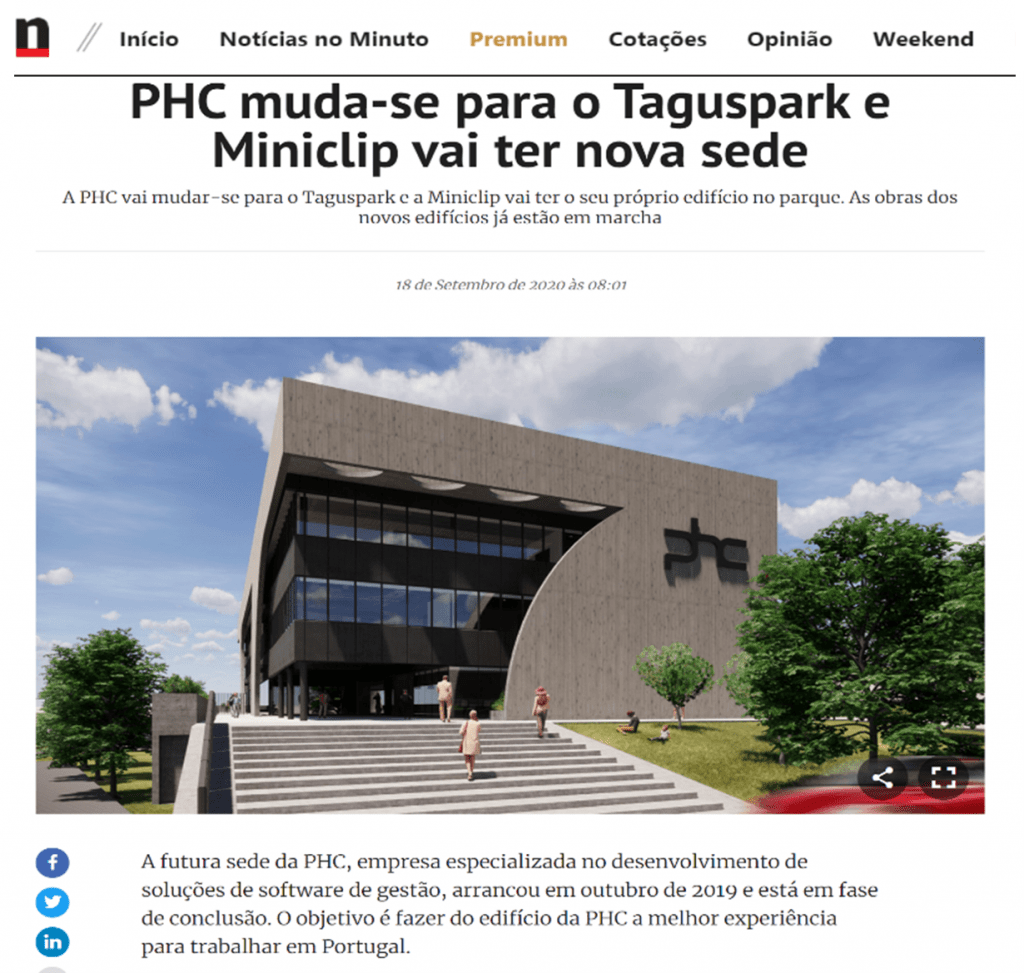
2020: https://www.jornaldenegocios.pt/negocios-em-rede/taguspark/detalhe/phc-muda-se-para-o-taguspark-e-miniclip-vai-ter-nova-sede
The new PHC identity was fully embedded in the new facilities that opened in 2021, as the concept of “Better Management for Happier People” reflects a turning point in the way the company views work and its employees. In this way, the headquarters are an extension of this new way of seeing the work environment.
OUR PROPOSAL/RESPOSTA
Deliverables:
- Media relations strategy
- One-to-one communication with specific media outlets
- Press realeses
- Build and strengthen the relationship with local reporters

https://hrportugal.sapo.pt/ja-foi-apresentado-o-escritorio-que-vai-revolucionar-o-futuro-do-trabalho-veja-o-que-distingue/
For this project, the chosen approach was the communication of the new office, highlighting the perspective of well-being and happiness of its employees. In this way, we create greater visibility to a new perspective of happiness of human resources, namely in the IT area, valuing a corporate culture of strong cohesion and maximum productivity. This project is a prime example of best practices in Employee Engagement, in a relaxed environment, but with a high degree of professionalism and productivity.
The ultimate idea to be shared by BloomCast was the message that the new PHC Software facilities in Taguspark, Oeiras, with a capacity for 300 job posts, are a window to the future of work and productivity among all companies. The building and the areas were designed from scratch to provide a hybrid work model where the feeling of working from home is combined with the interaction, cooperation, and creativity provided by the installations.
“BloomCast has been a trusted partner in the field of public relations, always available and with an excellent capacity for work. The result of this partnership is mirrored in several years of consolidation and growth of our media impact in Portugal, always aligned with our strategic goals. The communication about the House of Digital Business, PHC’s new headquarters, is an example of this”, says Nuno da Silva Jorge, Head of Corporate Affairs at PHC.
Find out more about the company which is revolutionizing the work experience in Portugal. PHC.
Here, to see other Success Cases.
Producing content for social media is more than building a simple text. Content marketing captures three times more leads than paid ads, so its essential to know the best tips for building relevant and organic content.
The idea of content marketing is increasingly present. 70% of marketeers invest in content marketing, 94% use social media to distribute it and 78% of organizations have teams composed of one to three content specialists for these specific situations.
However, professionals who create content for social media do not have to develop and implement strategies without any help since a good job in this field can also come from the use of online tools and software. There are several free and paid platforms (market analysis, social media management and analytics) that are an important complement when writing online content, since they not only improve the final result but also reduce the time spent on eventual changes, providing the possibility ofa better use forthat time.
The importance of market analysis to create content for social media
Before starting to develop content for social media and publishing it, it is essential to carry out a market analysis, in order to understand if the content produced and what you are thinking of producing is in the interest of the company’s target audience. In this way, there are several tools that can be interesting to understand, in greater depth, the research and information consumption trends, namely:
- Google trends is a free search trend tool from google. Through this tool it is possible to perceive, in real time, what information people are looking for. This search can be done using four parameters: location, date, category and type of search. Based on these categories, the platform is extremely useful for marketeers, since it allows determining a point in time where research related to the company is most common, giving the possibility of creating an extra effort in communication campaigns for these times.
- Answer the public, one of the best tools to define ideas for content you already have in hand. Although the free version has a limit on the number of searches (two per day), it is still an excellent tool to understand what is being researched about a certain keyword because the platform presents the main results related to “are”, “to what”, “why”, “who” and “how” of the selected keyword (for example: “What are B2B businesses?” being the keyword “B2B”).
- Ubersuggest is a tool, mostly free, that allows you to intuitively analyse the market, keywords and search volumes. This tool allows you find out how many times, for example, a website is searched and in what locations. It is an excellent way to understand which strategies work, adopt and improve them, thus gaining an advantage.
How to manage social networks?
In addition to market analysis tools, social media management tools also play a key role in the success of the online campaign,since they allow that the manual publication of content directly on the platforms to be optional. In other words, there are very effective tools that help in scheduling publications, videos or even stories, and through them we are able to suggest ideal times and days for publication. However, we must always keep in mind that scheduling publications does not damage the organic reach, but on the contrary, it may even enhance it, such as:
- Swonkie is a very complete social media management tool, since, in addition to creating and scheduling publications for Facebook, Instagram and LinkedIn, it also has a platform for influencers. Additionally, it allows you to respond to messages on Instagram and Facebook, as well as the creation of very complete reports. To use this platform, a monthly or annual payment is required, but it is one of the most complete for social media management.
- Socialbakers, one of the most used platforms worldwide, helps to build a better relationship with costumers and analyse the company’s position in relation to the segment’s market. Like Swonkie, Socialbakers also allows you to schedule publications and create reports on other companies in the same segment, evaluating the positive and negative points of the social media campaign in question. The platform has the option of a 14-day free trial, after which access is subjected to a monthly payment.
Data Analysis
In this sense, Analytics has several advantages. But first, it’s necessary to define what objectives you want to achieve with obtaining this data – for example, if you want to get feedback on a particular service, to boost public opinion about the company, among others.
- Facebook allows you to use Facebook analytics. This tool is quite complete and allows you to analyse the profile of the target audience and how it behaves on social networks and responds to each type of post published.
- Instagram also includes its own analytics that allow it to segment the audience of the page, in several aspects. Through analytics it is possible to monitor interactions and reach, as well as the performance of publications, stories and promotions. Although not as complete a tool as Facebook Analytics it is a great way to follow the activity of the Instagram
- Youtube has a very complete analytics tool, Youtube Studio, which allows you to obtain data such as the number of unique views and global appreciation of the content. And it is a completely free tool.
Despite all these tools, it is important to always bear in mind that the success of content marketing is not only based on these tools. Like most of the digital innovations that are emerging in the world, these tools help and speed up the work to develop, but they do not do everything. There needs to be commitment, ideas and team unity to build the best possible social media content, attracting new customers in order to obtain the best results.
To learn more consult our Social Media Guide, which is part of the BloomCast Content Series, a document developed by BloomCast Consulting with the aim of providing useful and easily actionable information to define the communication line that should be used in the company’s social media. In it you can find the best practices for managing the various social media accounts, as well as some relevant statistics and facts in relation to the format of each one.
TikTok is a Social Network that first appeared in September 2016, though, at the time, it was still mostly unknown since it was only available for the Asian market. It was never imagined that, four years later, the impact it would have on society would be this great.
In 2019 TikTok was the app with the most downloads worldwide, driven by the mandatory social isolation, due to the Covid-19 pandemic. Nowadays, this platform is in 9th place, being the most popular social network, according to Oberlo. With already 800 million active users, TikTok is much more than a network that allows the creation of short videos, using filters, music and effects, reproduced automatically; it is, in fact, a rapidly growing business. In this sense, TikTok had its biggest boom. According to a study made by Comscore, mentioned by eMarketeer, the application gained almost 20 million unique monthly visitors, representing an increase of 48.3% between January and March. In a span of months, TikTok has become a true case of success during a pandemic.
The world has changed and with it the habits of the population have also changed. In March, we became subjects of something never experienced: worldwide social isolation, which forced and encouraged people to look for new ways of communication and interaction with one another, even from a distance. And that’s exactly what TikTok represented to those who joined. However, this app is much more than a platform for young people. And, proof of that, is that in March, more than 70% of its users were aged between 18 and 24, but in April, this prevalence was reduced by 5.8% due to the entrance of users of all age groups, according to MediaKix.
Even though the TikTok market in Portugal is still relatively small, compared to the international market, with approximately 2 million users, there is still room to grow. Its trademark is the challenges and choreographed dances for instant reproduction that quickly go viral. With more time at the disposal of the Portuguese, the challenges are quickly adopted and its versions multiply, often with the presence of the whole family. Given this context, as with Facebook or Instagram, brands have also started to migrate to this new platform, since they realized that, on one side, this was where their target audience was (mostly Generation Z) and, on the other, because this is still a recent platform, in which they can bet on thedevelopment of innovative content and totally different from the other social networks.
However, developing content for TikTok is not the same as for other social networks and, although brands continue to bet on influencers in order to promote their product, they are also creating their own accounts and content themselves. And there are already several examples: Chipotle, an American fast food chain, started betting on the creation of short videos, in this application, to promote its menus and, currently, has 700 thousand followers. The National Basketball Association (NBA), has 11 million followers on its page, in which it uses TiktTk to demonstrate a totally different perspective from the one on their Instagram, for example. The objective is simple, when using informal and musical videos, they move away from their formal image, humanizing their athletes and, consequently, getting closer to their followers. The American Newspaper The Washington Post, was one of the first brands to enter TikTok, and despite being a formal and traditional newspaper, its Tiktok profile aims to be the opposite – informal and humorous, showcasing the behind the scenes of the newsroom. The lighter and informal tone fits in seemingly with this platform and the younger profile of the audience, whom they intend to reach.
In Portugal, the first brand to use TikTok to communicate was Disney, in 2019. Upon realizing that the younger generations (Generation Z) were no longer as present on the other social networks, such as Facebook or Instagram, they had to incorporate new ways of reaching them. In this way, the North American giant used Tiktok to promote the movie “Aladdin” aimed to a younger audience, between 14 and 18 years old.
But what are the reasons that make this social network so beneficial for a brand? The answer is simple and is related to its style: creativity and spontaneity. Contrary to what many people think, Tiktok is not just a network for children, in fact, on the contrary, the tendency is for more adult users to join.
However, it is important to emphasize some points. TikTok’s brand success is directly related to its own creativity. Simply copying what has already been done might not have positive results. After creating a video, it is important to look at it critically, and see whether it’s genuine. Look at who is in it and understand their body language, since discomfort is something easily noticeable. Finally, and perhaps the most important point: it’s essential to adjust the tone of the communication to the organization it represents. The NBA case works because it is associated with a sport. However, if a company taken as a formal and credible reference starts making informal videos with someone dancing, which has nothing to do with its core values, it may not have the best results and completely missthe established goals.
TikTok was, undoubtedly, very much driven by the pandemic, but it will not stop here. If the growth rates continue, in 2021 there will be more than 50 million users in the United States alone. Today, more than ever, companies must think smart and try to be where their customers are. If they don’t take advantage while its “trending”, certainly their competitors will.
The presence of a company in Social Media (E-book) has the main purpose of positioning it with an audience that seeks relevant information about its business, which is a “must” for all businesses regardless of their size. Every day, approximately one million users join the world of Social Media and currently 3.81 billion people, that is, 49% of the world population is already present on social networks and the trend is to continue growing.
However, it is not enough to have just one page on a social media network, it is also important that some good practices are followed and implemented, so that the organization can achieve the desired impact.
Thus, before moving on to implementing a strategy it is necessary to define it. Hence, in the first phase it is essential that the active social network accounts are identified, the objectives of the company for online presence need to be defined, as well as the audience that it intends to address.
On the other hand, nowadays, there are several platforms that exist that can make the choice more difficult. In this sense, we demystified the four networks that we believe to be the ones with the greatest potential for return on investment and the respective good usage practices to assist in the decision-making process: Facebook, LinkedIn, Twitter and Instagram.
While it may initially make sense to be present in all of them, this may not be true. And there may be platforms that do not make sense of the company’s presence, everything will depend on the objectives established.
After defining which platforms are most suitable, it’s necessary to define how to establish online communication, both textually and visually. And, for that, it’s essential to develop a market analysis, before starting to create and publish content, since it allows to understand if the produced content and what is being planned is of interest to the target audience.
However, it is crucial that companies when defining this strategy always bear in mind that, although each social network is intended for a specific target audience, communication should not be the same or exposed in the same way for all.
Creating content to feed social media can sometimes seem like a complex task, but to facilitate this process it’s important to define and take into account some good practices that end up being transversal to practically all networks, namely: the issue of tone of communication to be used, formatting, terminology, or even how links, hashtags or even emojis should be placed. In addition to the textual style, the visual part must always maintain the colour style and the same logos, regardless of the social network.
Being present in social media is more than having an account created, it requires care and attention in the way the brand/ company communicated, since it heavily impacts the public. For example, if the experience on social media is positive, 71% of customers are more likely to recommend the company to others.
Given this context and with these insights in mind, we have identified a set of tools that can be used to structured what you really want to communicate on your digital platforms.
The Social Media Guide, which is part of the BloomCast Content Series, is a document developed by BloomCast Consulting with the aim of providing useful and easily actionable information to define the communication line that should be used in the company’s social Media. In it you can find the best practices for managing the various social media accounts, as well as some relevant statistics and facts in relation to the format of each one.
The Covid-19 pandemic is a reminder that much of what happens to us in life is beyond our control. The times of emerging threats, such as the one that has been taking place are, as a rule, ideal for rethink or reformulating the communication strategies in times of a company’s crisis management.
In this case, there have been varying degrees of crisis management, which differ from company to company. However, some situations are directly related to the spread of the virus and arise from cases of contamination within the company. But, in most cases, crisis management may be insufficient just because the companies’ communication offices feel overwhelmed and little prepared to communicate a situation of this dimension, first to their employees and then to the outside world.
Thus, there are some steps that must be taken into account when facing crisis communication situations:
1 – Anticipate the event
The biggest change that needs to happen is related to the way of thinking of companies, regarding crisis management, which should, whenever possible, change their perspective of reactive communication to plan possible scenarios proactively.
While most companies may be prepared to deal with a crisis communication, some may not anticipate equally important strategies, such as mapping the risks of each option and communicating the recovery phases after crisis management. Prevention strategies can be especially important in communication for social networks, where feedback is direct and immediate and, in which digitization encouraged a change, not only in the speed of response but also in the content, channel and tone.
2 – Using technology in favour of the company
In times of crisis, digital tools may not be perfect, but they have a preponderant role when it comes to preserving data and, above all, they are extremely important in remote work situations, for example.
Analytics tools, whether predictive or not, can help the company prioritize potential system hacks as they help determine the likelihood of attacks. In this sense, companies that invest in technology to safeguard their cybersecurity are better prepared and are able, more easily, to understand what went less successful, what resulted and how to build better partnerships and alliances for the future.
3 – Preserving the company’s core values
The company’s culture and values are important pillars that help prevent a crisis and guide your response to one. Attention to detail and what is most essential to the organization’s culture can make the difference between effective damage control and more unfavourable situations.
So thatmanagers can help others within a company, it is necessary that they have support as well. In this sense, assigning specific roles, in a crisis communication situation may be important so that, at critical times, everyone knows what their role is and when it is necessary (or not) to involve someone else to guide work and help them succeed .
4 – Investing in Creative approaches
Different companies will face different challenges. In this context, it is important to invest in internal communication and solidify the corporate message, in a clear, but creative way.
Creativity can be the right way to overcome obstacles, whether referring to the company or its customers, in order to reach a target audience with transparency, empathy and honesty, preserving the human nature of the message.
5 – Prepare the return
It is essential that, from the beginning, in the crisis strategies to be implemented, possible post-crisis scenarios are also contemplated, so that organizations are able to derive insights on how they should prepare to become more robust in this return.
As we all know, in all crisis, there are companies that can adapt more quickly, recovering more easily or having less significant impact than others. According to BCG, for example, about 14% of companies increase revenues and margin in times of crisis.
In this way, there are several examples of companies, which anticipated scenarios and changes in behaviour and sought to take advantage of them, changing their business model to face the drop in sales and respond to new needs in times of pandemic. If they used to make 3D prints or car parts, now they manufacture visors. If they used to produce textiles or beer, now they make disinfectant.
Regardless of the scenarios, it is essential that organizations do not underestimate the importance of preparing and creating an effective crisis management strategy, because only then will they be one step ahead of their competition.
Between the financial crisis of 2008 and the current crisis, caused by the Coronavirus, there was a profound transformation of the communication processes and its underlying technologies. In 2008, e-mail reigned (although it still has an indispensable role), internet pages were not very dynamic and mostly searched through the computer, the desk phone was still an essential work tool and SMS the natural way to communicate in mobility. Many of the social networks were still emerging and business communication was mainly done through these more traditional and formal channels. But, while still in its infancy, digital transformation and mobility were spreading across all domains.
Let’s see: in 2001, Wikipedia was born, which revolutionized the access to credible information on a multitude of topics, opening the door to a world of knowledge available to everyone; in 2003 LinkedIn was born; in 2006 Facebook became a network open to any user; in 2007 the mobile phone experience was redefined with the iPhone and Apple Online store appears in mid-2008 with the surprisingly high number of 500 applications, starting the explosion of apps. The iPad was launched in 2010 as a reliable computing alternative and can be used anywhere comfortably and without the limitations of size and autonomy of notebooks. Uber and WhatsApp appeared in 2009 and, on the content side, the Ricky Gervais Show became in 2006 an instant success also in the podcast format, having broken several download records.
From then to the present moment, there has been an exponential growth of digital channels, with Facebook being the social network of choice, initially for younger generations. But they too have started to abandon it to move to Instagram, and more recently, to the TikTok video platform. On the other hand, Internet browsing is also done, mostly, on mobile devices and voice calls have been increasingly made in applications such as WhatsApp.
The moment of profound change that we are going through now will also have a significant impact in terms of customer expectations and the adoption of new technologies. On the other hand, it forced a reset, a potentially healthier redefinition of expectations, in which costumers and citizens, as a result of the feeling of insecurity and uncertainty that afflicts us all, started to give greater relevance to values such as credibility, trust and reputation. Furthermore, brands have recovered the theme of purpose, but now redefined and putting employees and society ahead of their shareholders.
This change also led to the acceleration of the digital transformation and the adoption and use of tools that allow to be closer to the customer in a easier format, closer to what would be a face-to-face reality. The fundamental theme is to provide a better experience for everyone, costumers and consumers. Online presence had the potential to allow much more than just knowing the brand. It also makes it possible to manage the relationship with costumers and, at the same time, create a more interactive and enriching relationship with each of them. Clearly, the organizations that can execute in this strategy, given the lengthy time expected under the current rules of relationship and social distance, will be the ones that will win.
In turn, the interaction models, powered by video tools, changed the way we managed to keep in touch, being now commonplace when, in the recent past, they were only possible with expensive videoconferencing equipment. The current online learning processes will also be overcome by models of much greater complexity and interaction, immersive and in which it is possible to recreate the face-to-face experience and stimulate the connection between students in a more dynamic way.
More importantly, it is important to remember that this transformation in still in its infancy, the result of technological developments that are promoting new scenarios and interaction models. Virtual augmented reality will transform our day-to-day lives, as many of these technologies become the norm in mobile phones, and as 5G networks become pervasive, creating what can be guessed an infinite bandwidth space for applications that take advantage of these technologies. Traditional mobility with mobile phones, smartwatches and wearable tech will create new experience models.
In other words, technology allows new approaches to communication and communication will have an impact on how it will be used. The creativity in using these new technologies to create better and more enriching experiences will surely surprise us and, when we look back at the reality prior to this crisis, the world will have changed.
Initially published in Executive Digest, online version. Opinion article by Rodolfo Oliveira, Managing Partner at BloomCast Consulting.
Change. Disruption. Transformation. Words often used but which, being used so often, seem to fall short in describing this new reality in which the model of society where we live has been profoundly altered. As always, in times of crisis, establishing a crisis office and revisiting plans, whether business or marketing, and re-evaluating strategies are in order. A change of plans without a defined strategy is potentially ineffective and, if there is no team focused on implementing and speeding up decisions, it is surely a bad path.
Essentially, any company or brand must operate at two levels of priority in the dialogue with its employees, customers and partners. At the first level, it must ensure that the contingency and adaptation plans to this new reality have been implemented, and that it has managed to reorganize itself to maintain its operation with a minimum of disruption. This phase should already be finished or in the finalization phase in the great majority of organizations, as well as defined support and connection initiatives for the teams, the ecosystem and the community in which the organization is integrated.
The second level should focus on the medium term and on understanding how to support its customers, showing the ability to innovate and present ideas, products and services that make it possible to address this new reality, which requires change, in order to use all digital channels available, either to exchange physical points of sale for digital ones or to keep in touch and answer customer questions and concerns. The digital transformation will be accelerated as never before, and companies will be forced to do so in order to maintain their operation.
This two-level thinking and the focus on the second one is key because a transition is beginning to take shape on the horizon, which is not the expected return to normality, but rather to a possible normality, a new normal, a term widely used to define the reality that emerged from the financial crisis and recession that started in 2008, and that will certainly be more digital, less face-to-face, and more distributed, creating new challenges, but also many opportunities for businesses that know how to innovate.
This approach should also be a reality in communications. In addition to the renewal and reinforcement of its own channels, the strong increase in news consumption by the media creates new opportunities. What kind of investments can be boosted? Clearly, branded content and the traditional media relations / earned media have strong potential. And, in this context, what kind of information should be placed as a priority? Providing a clear message of business continuity for the market, while also showing concern and proximity to the community, developing effective digital proposals, ensure all stakeholders are aware of the strategic vision of growth and evolution beyond the current situation are all valid ideas, as well as new products and projects. In other words, to communicate focusing on the medium term and on what characterizes and distinguishes the company.
At a time when we are connected to the computer for such long periods, sophisticated, objective and short email content should also be enhanced as a useful tool, as well as social networks. The worst option is certainly to reduce or stop communicating, because this decision creates an obvious uncertainty in the market, and a space for others to gain visibility.
Basically, this reality forces us to refocus on the fundamental. Whether we are consumers, costumers or suppliers, we are all emotional, we seek to establish long-term relationships, we appreciate sincerity, transparency and those who are by our side and support us when we seek guidance and support. This change will be a moment of transformation, with the inevitable consolidations and problems for those who are unable or unwilling to adapt, but those who know how to innovate in their offer, and communicate this difference, will surely be the winners.
Initially published in Meios e Publicidade, online version. Opinion article by Rodolfo Oliveira, Managing Partner at BloomCast Consulting.



